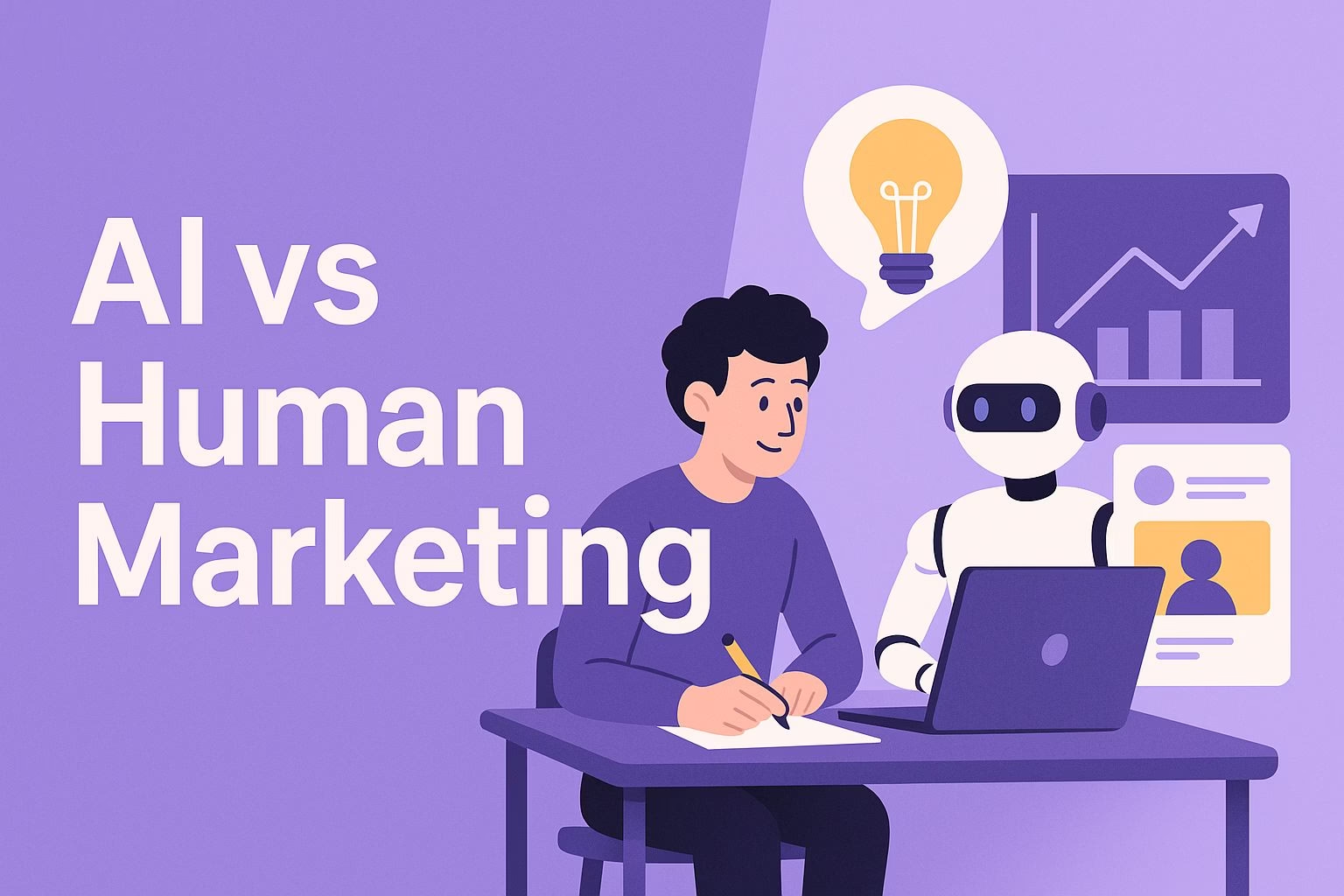AI vs Human Marketing: Where Small Businesses Should Invest
Key Takeaways
- Humans excel at storytelling, strategy, and creativity that feels authentic.
- AI outperforms humans in repetitive, data-heavy, and large-scale tasks.
- Costs are a major factor for small businesses, making AI more accessible.
- The best results come from blending both, AI for consistency, humans for voice.
- Blaze Autopilot helps maintain this balance by automating content while adapting to engagement.
- A hybrid system reduces stress, saves money, and creates sustainable growth.
- The smarter investment is not choosing one side but combining the strengths of both.
Running a small business often means wearing every hat at once. Marketing is one of the hardest to manage because it demands both creativity and consistency.
For years, the default option was hiring people or outsourcing to an agency, but that comes with steep costs and limited output. Now, AI tools are changing the picture, offering a way to scale without the overhead.
I have tested both paths, and the difference is clear. Humans bring strategy, storytelling, and intuition that no algorithm can fully match.
AI brings speed, affordability, and the ability to handle repetitive tasks at scale. The challenge is not deciding which one is better.
The challenge is figuring out where each one delivers the most value so the investment actually pays off.
This article is about drawing that line.
I will break down where humans should stay in control, where AI is the smarter option, and how small businesses can build a system that combines the best of both.
Where Humans Add the Most Value
No matter how advanced AI becomes, there are areas where people make the difference.
Storytelling is the first. Sharing experiences, values, and emotions connects with an audience in a way that algorithms cannot replicate.
When I talk about why I started my business or the challenges I faced, people engage because it feels real.
Humans also shine in strategy. AI can analyze data and suggest actions, but deciding on brand direction, positioning, or messaging still requires judgment.
A person who understands the business inside and out will always make better calls about where the brand should go.
Creativity is another area where humans stand out. AI can remix patterns and produce variations, but original ideas often come from human insight.
A clever campaign, a timely post that plays off cultural moments, or a heartfelt response to a customer are all examples of creativity that cannot be automated.
For me, keeping humans in charge of storytelling, strategy, and creativity ensures the marketing feels alive rather than mechanical.
What AI Handles Better
While humans excel at the high-level work, AI takes over when it comes to scale and repetition.
Writing dozens of captions, resizing graphics, or scheduling across multiple platforms are tasks that eat up time but do not always need a personal touch. AI can complete those jobs in minutes.
AI also handles analysis more effectively than I could on my own. Looking at performance data across hundreds of posts is overwhelming, but AI can identify patterns instantly.
It shows which styles, topics, or formats work best and then applies those lessons automatically.
That learning loop is something no single person has the capacity to maintain at the same speed.
The other strength is consistency. Life happens, and no matter how dedicated I am, there are weeks when posting slips.
AI fills that gap by running in the background, keeping my business visible even when I am not able to show up.
When I let AI handle the repetitive and analytical side of marketing, it freed me to spend more time on strategy and creative work.
That balance made the whole process more sustainable.
The Cost Question for Small Businesses
The biggest reason I started comparing AI with human marketing was cost. Hiring people, even part-time, adds up quickly.
Agencies often start with monthly retainers that run into thousands, and freelancers can become expensive when you need ongoing work.
For a small business, those numbers create pressure without guaranteeing results.
AI tools, on the other hand, usually cost a fraction of that. A single subscription can cover tasks that might take a full team to manage.
Writing content, designing graphics, scheduling posts, and even reporting on performance all fall within one package. That difference in cost makes AI an attractive option when budgets are tight.
The question is not just about the price tag. It is about value for money. Paying high fees for content that looks generic is not a smart investment.
At the same time, saving money on AI that produces work without personality is not much better. The real win comes from spending wisely on the mix that delivers results while keeping costs under control.
I realized that the investment should not be about choosing one side completely.
It should be about matching the cost to the return and using each resource where it makes the most sense.
Finding the Right Balance
What worked best for me was not treating AI and human marketing as competitors but as partners.
AI handles the heavy lifting, keeping the content machine running without me spending all day on it.
That gives space for human input in the areas that matter most: the stories, the strategy, and the creative spark that connects with people.
This balance also removed the stress of trying to do everything myself. Instead of spending hours on small tasks, I focus on the big-picture ideas.
AI ensures consistency and scale, while human effort keeps the brand authentic. The two approaches together produce better results than either one on its own.
Blaze Autopilot became one of the tools that made this balance possible. It creates and schedules posts automatically, but it also adapts based on engagement.
That means the content keeps improving while still sounding like my brand. By letting Blaze handle the repetitive cycle, I was free to stay involved in the parts of marketing that really need my voice.
The lesson I learned is that small businesses do not have to choose between AI or human marketing. The smart move is to invest in both, using AI for scale and humans for creativity.
That combination is where growth becomes both affordable and sustainable.
The Smarter Investment for Small Businesses
For small businesses, the real decision is not between AI and humans. It is about where to put limited resources so they create the most impact.
Spending everything on agencies or full-time staff can drain budgets too quickly. Leaning only on AI can save money, but risks losing the personal touch that makes a brand stand out.
The smarter investment is in building a hybrid approach. Let AI handle the tasks that require scale, speed, and consistency. Keep human creativity for storytelling, strategy, and authentic interactions with customers.
Together, the two create a system that works harder than either one on its own.
Once I shifted to this model, I saw growth that felt sustainable. I no longer worry about missing posts or wasting money on content that did not resonate.
My time went into the parts of marketing I enjoy, while AI worked in the background to keep everything running smoothly.
For small businesses like mine, that balance is not just efficient.
It is the key to marketing that grows with you instead of weighing you down.

